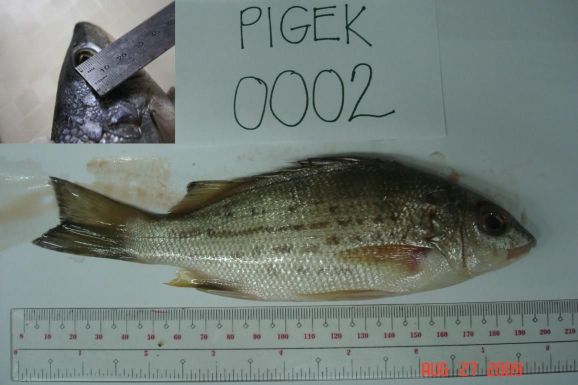VOLUME 5 NUMBER 1 (January to June 2012)

Philipp. Sci. Lett. 2012 5 (1) 030-039
available online: February 09, 2012
*Corresponding author
Email Address: mudjiesantos@yahoo.com
Submitted: January 23, 2011
Revised: November 28, 2011
Accepted: December 1, 2011
ARTICLE
Species and endemicity status of thetherapontid "Pigek", Mesopristescancellatus (Cuvier, 1829) in thePhilippines
by Benedict A. Maralit1, Minerva Fatimae H. Ventolero1, Rosario Segundina P. Gaerlan2, Macmod D. Mamalangkap3, Mudjekeewis D. Santos1,*
1 Genetic Fingerprinting Laboratory, Marine Fisheries Research Division, National Fisheries Research and Development Institute, Quezon City, Philippines
2 Bureau of Fisheries and Aquatic Resources – Region I, Pagdalagan Norte, San Fernando, La Union
3 Department of Agriculture and Fisheries – ARMM, ORG Compound, Cotabato City
2 Bureau of Fisheries and Aquatic Resources – Region I, Pagdalagan Norte, San Fernando, La Union
3 Department of Agriculture and Fisheries – ARMM, ORG Compound, Cotabato City
Aside from "Ludong" or President's fish(probably Cestraeus plicatilis), "Pigek" is alsoknown in the Philippines as a delectable, highlypriced and rare freshwater fish. Early reportsindicate that "Pigek" is of the speciesMesopristes cancellatus and popularly believed to only be foundin Rio Grande de Mindanao, Tamontaka River, and PulangiRiver in Cotabato. However, there have also been reports that"Bulidao", a fish caught in Abra River, is of the same species as"Pigek" because of their resemblance. Here, we confirmed theidentities of "Pigek" and "Bulidao" collected from Rio Grandede Mindanao and Abra River respectively, using morphomeristicsand genetics. Morphological comparison usingprincipal component analysis and three genetic markers:cytochrome oxidase subunit 1 (COI), Control Region, and largesubunit ribosomal DNA (16S), revealed that "Bulidao" and"Pigek" are indeed M. cancellatus species and are one and thesame. Results also suggest that M. cancellatus is widelydistributed throughout the Philippines contrary to what waspreviously thought. This bodes well for its management andconservation and calls for further studies to determine whetherthis fish species originate from or constitute a single stock.
© 2025 SciEnggJ
Philippine-American Academy of Science and Engineering